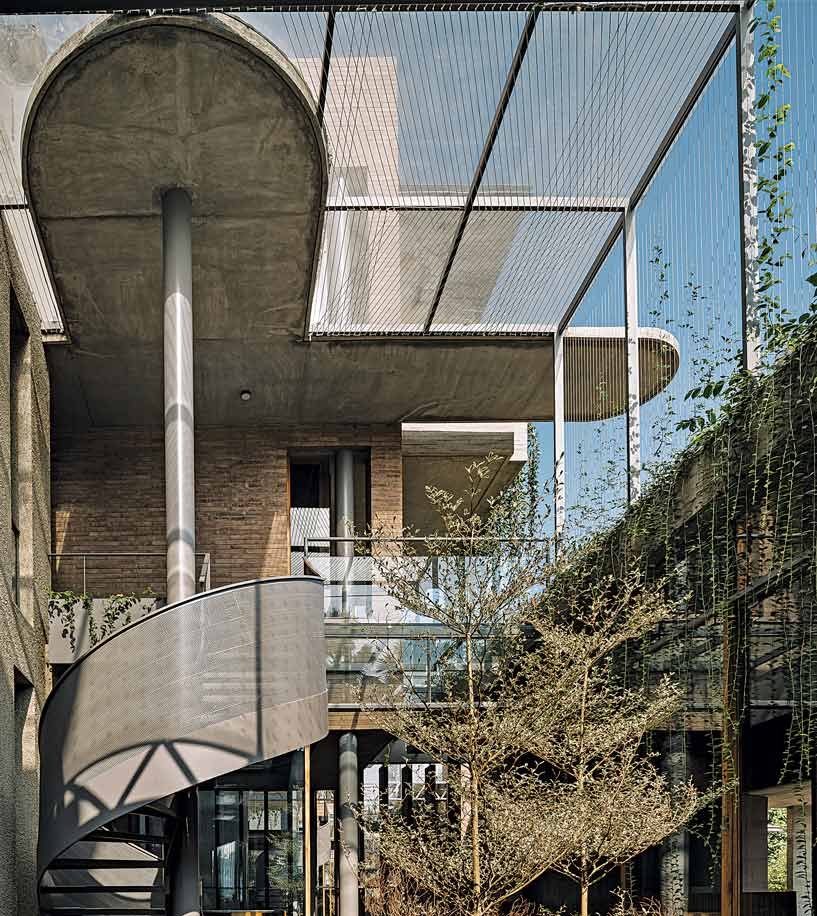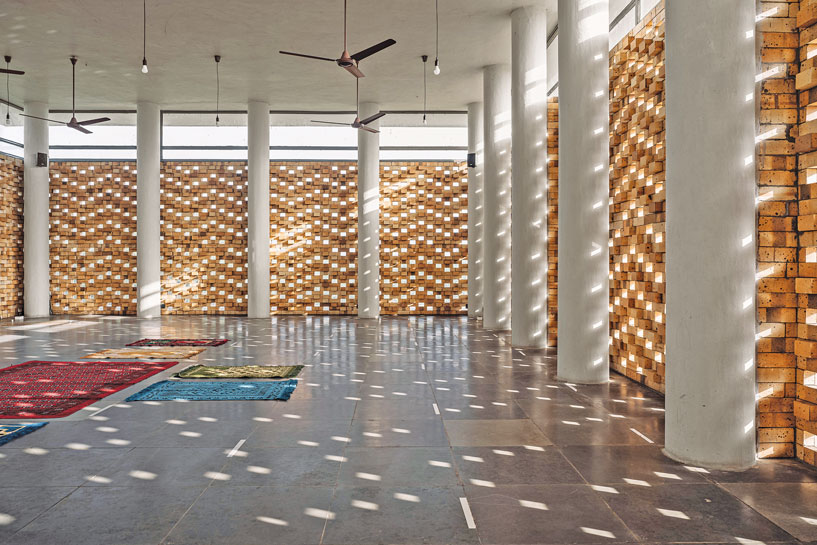
In the dynamic world of architecture and design, a partnership built on shared experiences and mutual respect can lead to extraordinary results. This is the story of Ar. Chinmay Laiwala, Ar. Jigar Asarawala, Ar. Tarika Asarawala, three friends turned partners of the architectural firm Neogenesis+Studi0261 based in Surat, Gujarat. Their journey began at the Faculty of Architecture, SCET, Surat, where they completed their Bachelor’s in Architecture. From their early days as interns at renowned firms to the launch of their own practice, their story is a testament to the transformative power of collaboration and a shared passion for design. In a conversation with SURFACES REPORTER® (SR), they share insights about their professional backgrounds, the challenges they’ve overcome, the projects that have defined their firm, and their advice for young architects.
Tell us about inception of your firm and initial phase of your architectural journey?
Jigar: All three of us attended the same college and were classmates. We completed our B.Arch. (Bachelor’s in Architecture) from the Faculty of Architecture, SCET, Surat. Chinmay pursued a Master’s in Urban Design from the University of Nottingham, U.K., and Tarika pursued a Master’s in City Design from SCET. For both Chinmay and Tarika, it was a conscious choice due to their inclination towards design and art.
Chinmay: For Jigar, it was the only option he could manage with his 12th grade score (laughs).
Tarika: At the beginning of our architectural journey, I interned at Kukke Architects, Bengaluru, and worked at Anagram Architects, Delhi from 2009 to mid-2011. Jigar interned at Raya Shankwalker Architects, Goa, and worked at PSDA, Delhi from mid-2008 to mid-2010, and Anagram Architects, Delhi from mid-2010 to mid-2011. Chinmay interned at Jaisim - Fountainhead, Bengaluru.Despite living in different cities, we always stayed in touch. One day, during a Facebook chat with Chinmay while he was in the United Kingdom, we made the decision to start a firm together.
Starting your own firm also means ‘making arrangements for necessary funds’, how did you manage that?
Jigar: Chinmay’s father lent us an office space of 300 sq ft which he owned. I and Tarika had saved money over a couple of years by working, which helped us in purchasing essential infrastructure such as computers and related equipment. So that’s how we started. As far managing the flow of capital is concerned, even we are still trying to figure it out. But on a serious note, we feel financial management should be introduced as part of the curriculum even for architecture students, so that going forward, they can manage money better.
As young architects how easy or difficult was it to secure your first project?
Chinmay: Architecture, in essence, relies heavily on word of the mouth. The initial projects often come from references provided by relatives, extended family, and friends. Similarly, we secured our first project (a residential project) from a client who had a close relationship with our families and was also known to us through our business circle. Having said that, going forward, the key to continued success lies in the quality and efficiency of your deliverables.
Which project proved to be the turning point for your firm and why?
Chinmay: Our project, Jungalow, has not only been a turning point but also a milestone in the firm’s early years of practice. It was through the execution of ‘Jungalow’ we captured the true essence of any house being built for the first time. This experience allowed us to better appreciate the parameters and elements such as the courtyard and volume. The innovative design solutions and sustainable practices we adopted truly shaped the firm’s philosophy. The response we received after its publication made us realize the power of media and publication in shaping public perception.

Jungalow 2 by Neogenesis+Studi0261
How does the approach towards a ‘design resolution’ alter with the scale of the project?
Jigar: Until now, the majority of our projects have been for private clients. We have only completed two or three projects for builders or MNCs. However, we believe that working with private clients allows us to delve into the smallest details of a project, as we have the opportunity to design from the macro to the micro level. When it comes to MNCs and builders, a detailed exploration of the design elements on a similar scale may always not be possible, owing to tight project timelines.
How does your firm ensure visibility and forge meaningful relationships?
Chinmay: The firm specializes in a distinct practice. Whether it’s a residential project, an institutional building, or a factory, we ensure that the firm’s philosophy remains intact. Our efforts are consistently centered around the intersection of architecture, contemporary culture, and current technology. So only those who understand our design language approach us. Our established client base supports us through positive word-of-mouth and active networking, while publications help us maintain online visibility and engagement.
What are your thoughts on architects doubling up as product designers?
Tarika: Clients nowadays seek customization and unique design solutions; they are aware of the market trends and inclined towards attention to detail. In response to this evolving nature of the profession, architects have taken on additional roles as product designers. Some view it as a way to enhance their skills, while others see it as an opportunity to enrich their brand.

Masjid E Zubaida / Neogenesis+Studi0261
Which international architectural trend would you like Indian architects to adopt, and vice versa?
Jigar: One trend we would like to see more in the Indian architecture and design fraternity is minimalism. The concept of “less is more” resonates with our approach to work and design. We strive to minimize clutter and create an environment that promotes a sense of calmness and serenity. Embracing minimalism can allow spaces to grow and evolve naturally over time. We also believe it is essential to work with restraint, both aesthetically and morally, and we encourage the fraternity to consider this idea.
Can you tell us about your notable clients and projects? How crucial are repeat clients for your firm?
Chinmay: Repeat clients play a crucial role in the long-term growth prospects of any architectural firm. Building strong relationships and working with clients repeatedly is much easier compared to acquiring new clients. The familiarity between both parties in terms of client preferences reduces extensive efforts and streamlines the process. Repeat clients are also more likely to refer us to their network, as word-of-mouth is a powerful and helpful tool for business growth. Some of our well-known clients include Dada Silk Mills, Detox Corporation, Venus Jewels, Hare Krishna Exports, Imperial Jewels, and Ashaktashram Trust.
In the list of notable projects,we have executed so far, I would like to mention Masjid-E-Zubaida in Raichur, Tej Farm, and a residence for the Sarpanch of Talangpore village near Surat. Recently, we completed ‘Jungalow 2’, which is also worth mentioning. Currently, we are working on a farmhouse in Surat, two institutional projects, a diamond factory, and several residential projects.
What advice would you give to young architects who aspire to set up their own firm?
Jigar: For young architects looking to establish their own firm, collaboration is the key. It is impractical for a single individual to handle all responsibilities and be the best at everything. Look for like-minded people who can fill in the gaps and complement your strengths. Additionally, identify your preferred design style and continuously improve upon it with the projects you undertake. While it is easy to get swayed by trends, it is essential to stick to your vision and pursue it consistently across projects in the
same category.
What message do you have for SURFACES REPORTER®? (SR) Magazine?
Tarika: We truly appreciate SURFACES REPORTER (SR) magazine for providing valuable insights that benefit the entire architecture and design fraternity. The content they produce is always valuable to readers and contributes to the ongoing dialogue in our industry. We are grateful for their contribution and support.
The interview appeared in the November-December edition of SURFACES REPORTER magazine.
Also Read:
Beauty of Earth Brick and Exposed Concrete at Jungalow 2 | Neogenesis+Studi0261 Architects
Modern Marvel in Islamic Architecture- Masjid-e-Zubaida Designed by Neogenesis+Studi0261